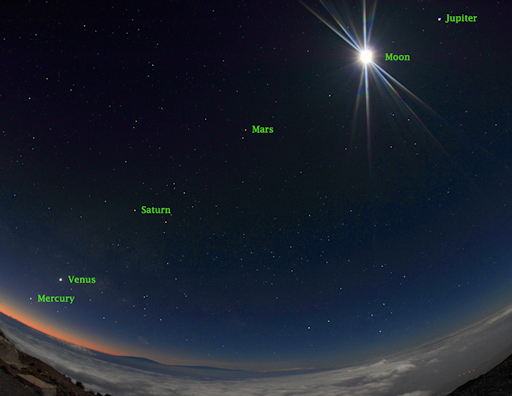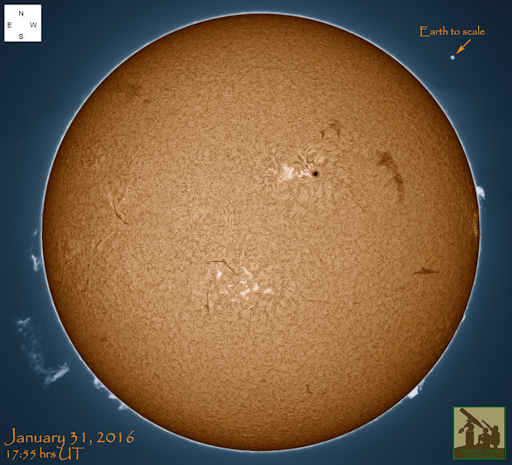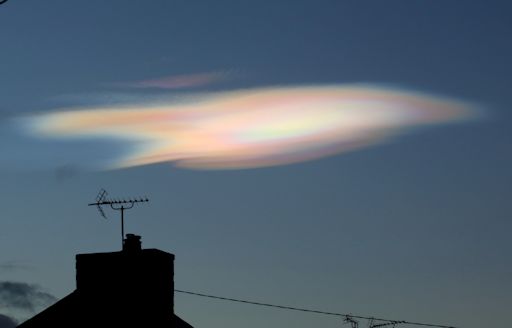Marianne's Heaven On Earth Aurora Chaser Tours Chasethelighttours.co.uk invites you to join them in their quest to find and photograph the Aurora Borealis. Experience the winter wonderland in the Tromsø Area. | | |
MOON-HOPPING: Five planets are lined up in the morning sky, and the Moon is hopping from one to the next. On Monday morning, Feb. 1st, the Moon visits Mars. Wake up an hour before dawn and look east for a loose lunar conjunction with the Red Planet: sky map.
This weekend, Rob Ratkowski woke up early and caught the Moon hopping from Jupiter to Mars. He sends this picture from the Haleakala Summit of Maui in the Hawaiian island chain:

"The line up was quite nice and, along with mild temperatures and winds, the brightening sky showed Mauna Kea and Mauna Loa on the Big Island in silhouette," says Ratkowski.
To take the picture, Ratkowski used a Nikon D700 digital camera with a 16mm Fisheye lens set at iso800 (f5.6) for a 15 second exposure. Other photographers may wish to take note of those settings, because the photo-ops are just beginning.
On Feb. 1st the half Moon is only a few degrees from Mars in the constellation Libra: sky map. Two mornings later, on Feb. 3rd, a fat crescent Moon passes by Saturn, only a few degrees away: sky map. And finally, best of all, on Feb. 6th, the slender crescent Moon forms a lovely triangle with Venus and Mercury: sky map. Circle these dates on your calendar--and set your alarm for dawn. The Great Naked-eye Planet Show is a great way to start the day.
Realtime Spaceweather Photo Gallery
ENORMOUS PROMINENCE, POISED TO ERUPT: Around the world, astronomers are monitoring a prominence of jaw-dropping proportions hovering over the sun's southeastern limb. It is located in the lower left corner of this picture, taken by Jim Fakatselis of Huntington, NY:

Earth, inserted for comparison in the upper right, is a veritable speck!
"I was really floored by the massive size of the prominence," says Larry Alvarez of Flower Mound, TX, who also photographed the structure. "It looked like a giant smoke stack billowing out solar material."
Fakatselis made a two hour video,which captures the smokey motions of plasma trapped inside the prominence's magnetic walls: play it.
Prominences like this one are highly unstable. Astronomers with backyard solar telescopes should train their optics on the sun's southeastern limb. An eruption may be imminent. Solar flare alerts: text or voice
Realtime Spaceweather Photo Gallery
POLAR STRATOSPHERIC CLOUDS OVER THE UK: An outbreak of polar stratospheric clouds (PSCs) is underway--but not around the poles. Sky watchers are reporting the beautifully-colored clouds over the UK. David Porter photographed this specimen on Jan. 29th from his home in Turriff, Aberdeenshire:

"I saw it just before sunrise," says Porter. "The cloud was colorful and highly reflective." Rob Powell of Stonehaven, Scotland, saw them, too. "It was a lovely sunrise," he says.
Also known as "nacreous" or "mother of pearl" clouds, icy PSCs form in the lower stratosphere when temperatures drop to around minus 85ºC. High-altitude sunlight shining through tiny ice particles ~10µm wide produce bright iridescent colors by diffraction and interference. Once thought to be mere curiosities, some PSCs are now known to be associated with the destruction of ozone.
"Nacreous clouds far outshine and have much more vivid colours than ordinary iridescent clouds, which are very much poor relations and seen frequently all over the world," writes atmospheric optics expert Les Cowley. "Once seen they are never forgotten."
Realtime PSC Photo Gallery
Realtime Aurora Photo Gallery
Realtime Comet Photo Gallery
Every night, a network of
NASA all-sky cameras scans the skies above the United States for meteoritic fireballs. Automated software maintained by NASA's Meteoroid Environment Office calculates their orbits, velocity, penetration depth in Earth's atmosphere and many other characteristics. Daily results are presented here on Spaceweather.com.
On Jan. 31, 2016, the network reported 9 fireballs.
(9 sporadics)

In this diagram of the inner solar system, all of the fireball orbits intersect at a single point--Earth. The orbits are color-coded by velocity, from slow (red) to fast (blue). [Larger image] [movies]
Potentially Hazardous Asteroids (
PHAs) are space rocks larger than approximately 100m that can come closer to Earth than 0.05 AU. None of the known PHAs is on a collision course with our planet, although astronomers are finding
new ones all the time.
On January 31, 2016 there were 1667 potentially hazardous asteroids.
Notes: LD means "Lunar Distance." 1 LD = 384,401 km, the distance between Earth and the Moon. 1 LD also equals 0.00256 AU. MAG is the visual magnitude of the asteroid on the date of closest approach. | | Cosmic Rays in the Atmosphere |
| Situation Report -- Oct. 30, 2015 | Stratospheric Radiation (+37o N) |
| Cosmic ray levels are elevated (+6.1% above the Space Age median). The trend is flat. Cosmic ray levels have increased +0% in the past month. |
| Sept. 06: 4.14 uSv/hr (414 uRad/hr) |
| Sept. 12: 4.09 uSv/hr (409 uRad/hr) |
| Sept. 23: 4.12 uSv/hr (412 uRad/hr) |
| Sept. 25: 4.16 uSv/hr (416 uRad/hr) |
| Sept. 27: 4.13 uSv/hr (413 uRad/hr) |
| Oct. 11: 4.02 uSv/hr (402 uRad/hr) |
| Oct. 22: 4.11 uSv/hr (411 uRad/hr) |
These measurements are based on regular space weather balloon flights: learn more. Approximately once a week, Spaceweather.com and the students of Earth to Sky Calculus fly "space weather balloons" to the stratosphere over California. These balloons are equipped with radiation sensors that detect cosmic rays, a surprisingly "down to Earth" form of space weather. Cosmic rays can seed clouds, trigger lightning, and penetrate commercial airplanes. Our measurements show that someone flying back and forth across the continental USA, just once, can absorb as much ionizing radiation as 2 to 5 dental X-rays. For example, here is the data from a flight on Oct. 22, 2015:

Radiation levels peak at the entrance to the stratosphere in a broad region called the "Pfotzer Maximum." This peak is named after physicist George Pfotzer who discovered it using balloons and Geiger tubes in the 1930s. Radiation levels there are more than 80x sea level.
Note that the bottom of the Pfotzer Maximim is near 55,000 ft. This means that some high-flying aircraft are not far from the zone of maximum radiation. Indeed, according to the Oct 22th measurements, a plane flying at 45,000 feet is exposed to 2.79 uSv/hr. At that rate, a passenger would absorb about one dental X-ray's worth of radiation in about 5 hours.
The radiation sensors onboard our helium balloons detect X-rays and gamma-rays in the energy range 10 keV to 20 MeV. These energies span the range of medical X-ray machines and airport security scanners.
| | The official U.S. government space weather bureau |
| | The first place to look for information about sundogs, pillars, rainbows and related phenomena. |
| | Researchers call it a "Hubble for the sun." SDO is the most advanced solar observatory ever. |
| | 3D views of the sun from NASA's Solar and Terrestrial Relations Observatory |
| | Realtime and archival images of the Sun from SOHO. |
| | from the NOAA Space Environment Center |
| | the underlying science of space weather |
| | Web-based high school science course with free enrollment |

